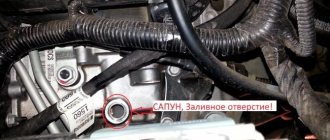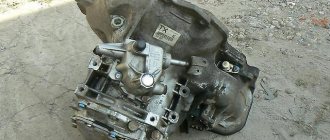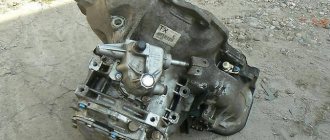Transmission oils for Lada Vesta have a wide range of products, unlike other AvtoVAZ products. Since entering the market in 2015, Lada Vesta has become one of the most popular models. The combination of consumer qualities and competitive prices allowed us to firmly gain a foothold in the top three sales leaders. At the same time, the car is distinguished by good reliability and ease of repair work. The same applies to the procedure for changing the transmission fluid in the box.
Types of gearboxes on Lada Vesta
In a short production period, the car was equipped with several types of gearboxes, which respectively required their own nuances when changing the oil in a Lada Vesta manual transmission:
- A domestic 5-speed gearbox with index 2191 was installed from the very beginning of production. This unit is a modernized version of the gearbox with index 2190, which was installed on the Lada Granta car, and the roots of the gearbox go back to the 80s. It is distinguished by good clarity when engaging gears, but only in comparison with its predecessor against the background of modern mechanical foreign competitors does it clearly lose. Also, as a result of modernization, parasitic vibrations on the handle have disappeared, the lever stroke has been shortened, and the volume of the crankcase has been reduced. This unit is the most unpretentious and relatively reliable. The manufacturer claims a total resource of 150 thousand km, which many owners have managed to achieve and even exceed. In addition, this unit requires less maintenance and prevention compared to foreign competitors, which is a definite advantage in domestic operating conditions.
- The French 5-speed gearbox is installed on versions with a more powerful 1.8 liter engine, as well as previously in “top” versions with 1.6 liters. The unit is distinguished by better switching selectivity (although also not ideal), ease of maintenance and relative reliability. The safety margin is more than enough to “digest” the engine torque.
- Robotic AMT is installed in tandem only with domestic mechanics. This unit is a mechanical box with an installed electronic unit and several actuators responsible for automatically engaging gears. Among all types of gearboxes, both in operation and when changing the oil in the Lada Vesta robot, it is labor-intensive, which also largely entails low demand for these models. The weak point is the mechanical part of the box, which when paired with an electronic unit is subject to increased wear, imperfect switching technology, “strong thoughtfulness,” rapid wear of the clutch, which often cannot “go out” even after 50 thousand kilometers. All these factors make this transmission the least attractive.
- According to the developers' promises, an automatic transmission will appear in this model only in 2022. Previously, there were rumors about AvtoVAZ’s own development of an automatic transmission with a valve body or about the use of a Japanese unit that was installed on the Lada Granta. However, the most likely option is to install a Japanese Nissan CVT in the car paired with a naturally aspirated 1.6 liter engine of the same Japanese production. Accordingly, only after the release of a model with a full-fledged automatic transmission can you find out the conditions for changing the oil in the Lada Vesta automatic transmission.
The sports version is also equipped with a French gearbox with a reinforced design due to the increased engine torque, as well as increased oil requirements.
Top 1. Castrol Syntrans Transaxle
Rating (2021): 4.83
The most effective oil has enhanced extreme pressure characteristics and synchronizing properties compared to oils of the GL-4 standard. With it, the manual transmission does not experience wear and tear for many kilometers.
- Characteristics
Average price: 999 rub./l
- Country: European Union
- Type: synthetic
- API Standard: GL-4+
Expensive but popular European oil, which has enhanced extreme pressure characteristics and synchronizing properties. Effectively reduces temperature, increases the wear resistance of transmission elements, and ensures its long and stable operation. Drivers like how the oil protects the components of the gearbox from wear and how smoothly the gears change with it. It behaves well in hot weather and does not thicken in cold weather; the Castrol box is quieter. However, as often happens, the more popular and better quality the product, the more attractive it is to counterfeit manufacturers. You need to be careful with Castrol oil and buy it only in trusted places.
Advantages and disadvantages
- High efficiency
- Stable performance in cold weather
- Securely preserves box parts
- High price
- There is a counterfeit
See also:
- 10 best tires for Lada Vesta
to the beginning of the rating
When do you need to change the oil in a Lada Vesta gearbox?
The manufacturer indicates in the operating book all the work required to be carried out during the warranty period, which is 5 years or 100 thousand km. However, depending on the type of gearbox, the shift timing also changes:
- In the domestic 5-speed gearbox, the procedure for changing the substance is regulated once every 90 thousand km. This is a rare case when a manufacturer regulates a replacement figure that is close to the real one, tested in practice. In this case, this operation falls under the mileage warranty period and can be carried out at the expense of the manufacturer. In some cases, in practice, experienced owners reduce this interval to 70 thousand mileage and change the substance immediately after purchasing the car.
- Changing the oil in the AMT Lada Vesta is also regulated once every 90 thousand km. However, if the mechanics are not so demanding on this operation, then the robot will not be able to run the promised 150 thousand km without complying with the regulations. Owners change the oil in this case already at 40-50 thousand km in order to avoid early breakdowns of the unit and its complete failure.
- For French mechanics, the regulations do not provide for fluid replacement at all - it is filled in for the full life cycle of the box. However, as with any manual transmission, scheduled replacement is a mandatory procedure. Owners also change the fluid every 70-80 thousand kilometers, which allows the unit to cover a distance of 200 thousand.
Reviews
| № | Positive |
| 1. | Vasily , 34 years old (drive2.ru): changed the lubricant on the mechanics for the first time at 20,000 km. The color is brown, there are not a lot of metal shavings. I filled in the same thing - factory semi-synthetic from Lukoil. |
| 2. | Dmitry Mikhailovich , 46 years old (prom.ua): the mileage of the Lada Vesta is 52,000 km, the condition of the manual transmission lubrication is still good, but it is advisable to “update”. I bought three liters of Rosneft, semi-synthetic, as part of the promotion. |
| 3. | Alexey , 36 years old (drom.ru): I have no complaints about the machine, it works properly. Total mileage 35,000 km. I regularly visit service stations, carry out diagnostics, and buy original consumables. |
| 4. | Petrovich , 47 years old (rozetka.ua): I renewed the lubricant for the first time at 2000 km, after purchasing it from the dealership. The color of the liquid was natural, there were practically no shavings. After filling it with Rosneft on a synthetic basis, my comrades advised. |
| 5. | Vyacheslavovich , 48 years old (Auto.ru): did not wait for 75,000 km, as recommended by the manufacturer, updated the “lubrication” in the mechanics already at 50,000 km. The box is working normally, there are no comments. |
| 6. | Semyon Vasilyevich , 44 years old (Auto.Mail.Ru): for three years of active use of the car there were no breakdowns, only scheduled technical inspections. I take good care of my equipment, observe the replacement intervals for consumables, and have a moderate driving style. |
| 7. | Dmitry Stepanovich , 47 years old (drive2.ru): The Lada Vesta is five years old and has never changed the oil in the box. The manufacturer recommends I won’t wait at 75,000 km, I’ll update at 60,000 km. I don't think it will get any worse. |
| 8. | Andrey Sergeevich , 49 years old (drive2.ru): I have an old Vesta, still mechanically from the French. Over five years of active use, I replaced the transmission fluid twice. There are no complaints about the manual transmission, it works normally. |
| Negative | |
| 9. | Gennady Dmitrievich , 53 years old (prom.ua): a rustling sound appeared at idle, after diagnostics in the workshop they said that it was necessary to replace the bearing in the box. The car is only three years old, but it already requires investment. |
| 10. | Vladimir , 48 years old (Bibika.ru): problems with the transmission began after several thousand miles. There was noise when moving, slight vibration. I will go to a service station for diagnostics followed by repairs. |
| 11. | Boris Sergeevich , 48 years old (drive2.ru): over the four years of using the car, I have already contacted the service center several times to troubleshoot the machine. Frequent delays (pauses) when switching, vibration when moving. |
| 12. | Sergey Vasilievich , 47 years old (Avtodispatcher.ru): changed the oil unscheduled, at 30,000 km. Already at that time the grease was dark brown in color. Which indicates the low quality of the oil. I filled it with imported Mobile, my garage mates recommended it. |
Related link:
Lada Vesta clutch.
What kind of oil to put in the box of Lada Vesta
The manufacturer in the car service book provides a list of recommended oil manufacturers whose products it is advisable to purchase. However, the owner may not adhere to this list, but only look for similarities in the characteristics of the substance. There are 3 main types of transmissions on the market:
- Synthetic oils are products of complex chemical synthesis. They have a large number of different additives and have a positive effect on the operation of the unit, increasing its efficiency. Despite their high cost, they are in consistently high demand on the market. The only drawback is high fluidity, which can have a negative impact in severe frosts - the product can be squeezed out through the seals.
- Semi-synthetic substances are most often used on transmissions with high mileage, when synthetics will often leak. They have less fluidity, but at the same time they are inferior to it in washing and cooling properties. Moreover, such a product is cheaper than a completely synthetic substance.
- Mineral products are less common on the market due to old production technology. New gearboxes cannot effectively reach their potential with this substance. It can only be used in the extreme conditions of the far north with constant sub-zero temperatures.
How much oil is in a box of Lada Vesta
Also, depending on the type of boxes and their origin, the volume of the substance and the cost of changing it vary:
- in the domestic box the oil volume is 2.8 liters, which is quite modest by the standards of the class; accordingly, the volume of oil in the Lada Vesta gearbox required for a full change will be about 6 liters, and for a partial one about 2 liters;
- in French mechanics, this figure is 3.8 liters, which is 1 liter more than the domestic version; for a full change, about 8 liters will be required, for a partial change, about 3 liters of the substance;
- in a robotic gearbox this value is equal to 3.5 liters of oil, since it is based on a domestic manual gearbox, for a complete oil change you need 7-8 liters, for a partial top-up about 3 liters of oil.
How to change the oil in a Lada Vesta box
Product changes are carried out both in-house and at service stations. If this operation is carried out independently, the owner will need a lift, a set of keys for removing the crankcase protection, a new oil filter and containers for filling and draining waste material.
Complete oil change in the box of Lada Vesta
A complete change of material is carried out in several stages and on average takes about 2-3 hours, regardless of the type of gearbox:
- it is necessary to lift the car on a lift and remove the crankcase protection;
- after this, you should substitute a drain container and unscrew the drain plug; the used oil will flow by gravity into this container within an hour;
- after this, the oil filter should be replaced and new material should be filled to the required level;
- After topping up, you need to start the engine and turn on all the gearbox operating modes one by one.
What does oil viscosity affect?
The viscosity of transmission oil has a great influence on the vehicle's gearbox. With high viscosity, delays in gear shifting may occur, the sliding time of gearbox components increases, which increases wear, but reduces the noise of the gearbox. Oil, on the contrary, with low viscosity, is not able to create a strong film between surfaces. So, if it is destroyed, the elements begin to work “dry”, which contributes to wear.
You can easily feel the viscosity of the oil in winter at very low temperatures when starting the car.
Changing the oil in a robot is a bit of a difficult task, because... the factory did not provide for this operation. To replace, you will need a large syringe for pumping oil. Home page
How to check the oil in the box of a Lada Vesta
Checking and monitoring the level of the substance in the crankcase is carried out not only as part of the replacement itself, but also for preventive purposes. In the event of a critical drop, it is necessary to urgently fill in a new substance and go to diagnose the box. At the same time, depending on the type of box, the methods for checking the oil in a Lada Vesta box differ:
- A simple mechanical box of domestic production contains a plastic probe with printed levels of the optimal volume value. To check, you need to remove the dipstick from the engine compartment and check it against the marks. At the same time, the owner can evaluate not only the level of volume, but also the consistency of the product, which is also important. If there are metal shavings, thickening or a dramatic change in color, the transmission must be replaced.
- The remaining units have a control plug that shows the fluid level in the crankcase. To check, you need to lift the car on a lift, remove the crankcase protection and look at the current oil level.
Why do you need to change transmission fluid?
Lada Vesta transmission oil consists of a petroleum base and special additives, which, over time, not only cease to perform their intended functions, but also disintegrate. This process is accelerated by an aggressive driving style, abrupt or untimely gear shifting. “Waste” oil ceases to protect the parts of the Vesta gearbox and cool friction pairs. In addition, metal shavings settling at the bottom are carried throughout the mechanism, which can contribute to the occurrence of scuffing and rapid wear of the main pair.
Answers (1)
Owners and dealers fill the Lada Vesta manual transmission with 75W90 Gl4 gear oil, although 75W80, 85 are also possible. It is simply the most universal and suitable for the widest temperature range.
What can be filled from what the owners have already chosen?
Castrol Syntrans Transaxle (75w-90 GL4+) Zic GFT 75W90 LIQUI MOLY 75 W 90
The filling volume according to the passport is 2.34 liters, however, in reality it takes 2.4-2.5 liters, depending on what level you fill it to.
As for the interval, it is not indicated by the manufacturer, so it is usually changed every 30-40 thousand km, but most often on later runs.
The current manufacturer's regulations do not provide for changing the oil in the gearbox of a Lada Vesta. Some owners are inclined to believe that the factory is right here and there is absolutely no need for this procedure, because the oil must function throughout the entire service life of the car. Along with this, there is a category of owners who are convinced of the need for periodic replacement, and it is recommended to carry out the primary procedure before the 1st maintenance.
In this article we will try to figure out: is it necessary to change the lubricant in Lada Vesta gearboxes? And also, what kind of oil should I put in the gearbox?
Review of Manufacturer Prices
| Name / article / viscosity grade | Price in rubles (liter) |
| Mobile 1 SHC (75W/90) | From 650 |
| Lukoil TM-5 (75W/90) | From 370 |
| Castrol Suntrans Transaxle (75W/90) | From 550 |
| Mobile GX (80W) | From 600 |
| Lukoil TM-5 (85W/90) | From 350 |
| Lukoil PSNT (75W/90) | From 350 |
*prices are as of March 11, 2019.
Is washing necessary, which one to choose?
It is necessary to flush an automatic transmission:
- after long-term operation with old oil;
- when replacement deadlines are delayed;
- frequent use of equipment under load.
Tranself 75W-80
In all other cases, it is enough to limit yourself to the usual replacement according to the “drain-fill” principle. However, the manufacturer does not prohibit washing the “robot” every time the fluid is changed. The decision is made by the car owner individually.
Types of boxes used in Vesta
The manufacturer has provided several options for transmission units. The first copies of Lada Vesta rolled off the assembly line equipped with manual transmissions. The donor was the famous Renault brand.
Also a common configuration was the Lada Vesta with the domestic “AMT” “robot”. After some period, they decided to abandon the French unit in favor of a modified box design of Russian origin.
How to find out which unit is present on a particular car?
To do this, you need to familiarize yourself with the VIN code:
- “GFL11” – “mechanics” “VAZ-21807”;
- “GFL12” – “robot” “AMT”;
- "GFL13" - mechanical unit "Renault JH3 510".
Is it worth changing the oil?
Let us remind you that the technical documentation of both the French unit and the domestic “robot” does not provide for changing the oil in the gearbox. Whatever the factory has filled should continue to run for the entire “life” of the machine.
The situation is different with the VAZ gearbox: here the manufacturer insists that the oil in the gearbox be changed after 75 thousand km or after a 5-year period. However, the official dealer’s maintenance regulations do not provide for this kind of procedure.
Some owners are concerned about the oil that was initially poured into the unit at the factory, because the quality may be significantly lower than the required standards. Those who decided to replace it note that the color of the repair does not inspire confidence and will definitely not be “useful” for the unit during further operation. However, this is the opinion of ordinary people, since experts on this topic do not make official recommendations.
“Witnesses” of replacing the lubricant claim that after this “miraculous” procedure, the box began to shift more clearly, the sound and other previously occurring defects disappeared.
Tips and tricks
If possible, try to always replace the gaskets under the drain plug. Considering that this element is not at all expensive, this recommendation is quite relevant. This approach will allow you to achieve the required tightness and avoid oil leaks from the gearbox during further operation of the vehicle.
You can also find information that fresh oil can be poured into the Vesta gearbox through the hole in the reverse switch. In practice, it is more convenient to fill in oil this way. The fact is that the hole is located on top, in contrast to the oil level control hole in the gearbox, located on the side.
If, when draining the old oil, it is noticed that the waste is very dirty or dark, it contains impurities or particles of metal shavings, then it is best to flush the gearbox before replacing it.
We also recommend reading the article about what kind of automatic transmission is installed on the Lada Granta. From this article you will learn about the features, operating principles and design of the automatic transmission on the Lada Granta.
The easiest way is to fill in the recommended oil, which will then be replaced after 2-3 thousand km. Flushing oils can also be used. First, study the instructions, paying attention to the instructions from the manufacturer of the composition. Then wash is poured into the gearbox, after which one drive wheel should be raised.
Next, you should start the internal combustion engine on the car with the drive wheel hanging out, then engage second gear and leave the engine running for a few minutes (check the washing instructions for details). At the end, you need to turn off the engine, drain the flush, after which fresh oil is poured into the gearbox.
After changing the oil in the Lada Vesta gearbox or on other cars, it is recommended after 2-3 thousand km. Unscrew the control plug and check the level, if necessary, add lubricant so that the level rises to the edge of the hole. It is also important to ensure that there are no oil leaks in the area of the drain and control plugs after replacing the lubricant in the gearbox.
Vesta engine oil
What kind of oil should I put in the gearbox? The plant uses TM-4-12 SAE 76W-85 GL-4 fluid. This semi-synthetic fluid is all-season, and it also contains additives of imported origin. The operating temperature range of the lubricant is: minus 40 to – plus 45°C, and the filling volume is 2.2 liters.
Experts recommend using “ZIC G-FF 75W-85” oil as an alternative for Lada Vesta units.
Here are a couple more options for suitable lubricants:
- "TRANSELF NFJ 75W-80";
- "Hochleistungs-Getriebeoil 75W-90".
Important! Incorrectly selected and filled oil will cause breakdowns in the switching mechanism. A liquid of a higher category (in terms of viscosity and other properties), if it is not applicable to a specific unit, will cause harm to it.
Technical characteristics of popular Liqui Moly oils
Since the company’s product range is very extensive and continues to expand, it makes sense to provide a description of the features and technical characteristics of the most popular oils for different types of transmissions.
Hochleistungs-Getriebeoil 75W80
Hochleistungs-Getriebeoil 75W80 oil is intended for use in robotic preselective gearboxes. Provides quick engagement and disengagement of friction clutches, optimal functioning of hydraulic servos, high-quality lubrication of synchronizers, gears and other transmission parts. Features of Hochleistungs-Getriebeoil 75W80 liquid:
- almost ideal viscosity-temperature properties;
- excellent shear stability;
- high wear resistance;
- excellent antioxidant properties, resistance to aging.
Specifications:
- viscosity index at a temperature of 40° C – 33.00 mm2/s;
- viscosity index at 100° C – 6.85 mm2/s;
- viscosity index at a temperature of -40° C – no more than 20,000 mPas;
- ignition temperature – 200° C;
- critical crystallization temperature – minus 48° C.
Top Tec MTF 75W80
Top Tec MTF 75W80 oil is used in mechanical gearboxes, power take-off units and transfer cases. Recommended for use in manual transmissions from most well-known car manufacturers. It is characterized by a high degree of protection of transmission components from wear.
Features of Top Tec MTF 75W80 fluid:
- ensuring fuel efficiency;
- excellent anti-corrosion properties;
- resistance to high loads;
- decent viscosity-temperature parameters;
- ensuring optimal operation of synchronizers.
Specifications:
- viscosity index at a temperature of 40° C – 53.60 mm2/s;
- viscosity index at 100° C – 9.30 mm2/s;
- viscosity index at a temperature of -40° C – no more than 150,000 mPas;
- ignition temperature – 202° C;
- critical crystallization temperature – minus 45° C.
Getriebeoil 85W90
Getriebeoil 85W90 is a GL4 class mineral transmission fluid intended for use in manual transmissions of trucks and passenger vehicles. It is characterized by the use of base mineral components of the highest quality and a complex of additives and modifiers that ensure clear and fast gear shifting.
Features of Getriebeoil 85W90 oil:
- possibility of use in gearboxes with all types of bevel and cylindrical gears;
- full compatibility with all modern seals;
- all-season use.
Specifications:
- viscosity index at a temperature of 40° C – 197.00 mm2/s;
- viscosity index at 100° C – 17.60 mm2/s;
- viscosity index at a temperature of -12° C – no more than 150,000 mPas;
- ignition temperature – 220° C;
- critical crystallization temperature – minus 15° C.
Hypoid-Getriebeoil TDL 75W90
Transmission oil Hypoid-Getriebeoil TDL 75W90 is a semi-synthetic fluid designed for filling into manual transmissions of passenger and heavy vehicles, drive axle gearboxes and transfer cases. It features high-quality protection of transmission parts from wear and ensures clear and fast gear shifting.
Features of Hypoid-Getriebeoil TDL 75W90 fluid:
- wide range of temperature conditions;
- ability to provide high temperature and viscosity stability;
- Possibility of use in highly loaded transmissions.
Technical characteristics of gear oil Liqui Moly 75w90 Hypoid-Getriebeoil TDL:
- viscosity index at a temperature of 40° C – 81.20 mm2/s;
- viscosity index at 100° C – 14.20 mm2/s;
- ignition temperature – 180° C;
- critical crystallization temperature – minus 43° C.
Hochleistungs-Getriebeoil 80W90
Hochleistungs-Getriebeoil 80W90 is a synthetic fluid of class GL-4/5, intended for filling into manual transmissions of passenger cars, including models in which the transmission is coupled to the final drive. The oil ensures clear and fast gear shifting and effective protection of transmission parts from wear.
Liqui Moly Hochleistungs-Getriebeoil 80w90 gear oil has the following special properties:
- excellent temperature-viscosity properties;
- effective protective action against corrosion and wear;
- possibility of use in highly loaded transmissions;
- easy gear shifting.
Specifications:
- viscosity index at a temperature of 40° C – 77.00 mm2/s;
- viscosity index at 100° C – 14.00 mm2/s;
- viscosity index at a temperature of -40° C – no more than 150,000 mPas;
- ignition temperature – 215° C;
- critical crystallization temperature – minus 42° C.
What is needed for replacement?
The process is quite simple and understandable to the average owner. Here you will need to stock up on the following supplies:
- keys and slotted screwdrivers;
- capacity for collecting waste (about 2.5 - 3.0 liters);
- a piece of 20 mm hose and a funnel.
To drain the oil more easily, the LADA Vesta box should be preheated. A trip of 10-15 km will help.
Changing the oil in the Russian Vesta
- We place the car above the pit (horizontally);
- dismantle the engine protection of LADA Vesta;
- unscrew the plug that closes the hole to check the level;
- substitute the container in advance;
- unscrew the drain plug (an 8 mm square key is required);
- “release” all the lubricant into the container, waiting for the drops to completely disappear;
- we return the same plug to its original place, replacing the copper o-ring;
- Insert the specified hose with a watering can into the inspection hole and fill in oil;
- We do this until the liquid approaches the lower edge of the hole;
- After tightening the plug, install the pan protection.
Alternatively, the replacement can be carried out by supplying oil to the hole for the reverse gear switch. This is easier because it is located on top of the unit body rather than on the side panel like the inspection hole.
Important! After draining the old grease, we look at its condition. If it is dark in color and contains small metal particles, then the unit should be washed before adding new fluid.
For this purpose we do this:
- pour about 1.5 liters of flushing agent;
- hang out one of the drive wheels;
- start the engine and engage 2nd gear;
- After “driving” in this way for a couple of minutes, turn off the engine and drain the “flushing”;
- Now you can fill in new oil.
Flushing the gearbox
Not all car enthusiasts share the opinion that it is necessary to flush the transmission when changing the fluid. The manufacturer does not directly indicate the need in the operating instructions, but implies this procedure.
Service station technicians advise flushing the transmission constantly, especially if maintenance deadlines are not met or if there is long-term operation. The transmission oil changes color to dark, metal particles and waste products appear in the composition.
The flushing process is similar to replacing fluid in a manual transmission:
- We place the machine on a hydraulic lift and drain the waste.
- Through the control hole, fill in a volume of 1.5 liters of flushing, no more.
- We start the engine, engage first and second gear for 10 - 15 minutes.
- We drain the waste and fill in new oil.











